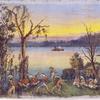Public Re-Opening of Gracie Mansion will Showcase Art Additions
- October 14, 2015 12:22
Gracie Mansion, the official residence of the Mayor of New York City, has once again been transformed. Built in 1799, the stately Federal style mansion (East End Ave and 88th St.) underwent a $7-million restoration in 2002, and when first occupied in 2014 by Mayor Bill de Blasio and his wife, First Lady Chirlane McCray, some antiques were removed. The family's private rooms were decorated with furniture from catalog retailer West Elm. Now, the mansion's art collection has been curated with a fresh approach.
Gone is a portrait of George Washington, among other historic works, according to commentators in The Wall Street Journal. A curated re-hang of art, including loans from museums, reflects the diversity of New York City's people and history, specifically during the time period of Gracie Mansion's original occupants.
The city's website released the news:
In honor of its 35th anniversary, the Gracie Mansion Conservancy has announced the beginning of an art installation at Gracie Mansion, titled “Windows on the City: Looking Out at Gracie’s New York,” which consists of previously and newly acquired works. All of the additional pieces come from the original Gracie Mansion period.
The installation, which includes 49 new works – paintings, objects, historical documents and more – focuses on the late Colonial, Revolutionary, and Federal Periods, a timeline that runs roughly from 1763 to 1825. Highlights include stoneware from a free African American, a portrait of the daughter of the then-governor of Connecticut, Native American artifacts, Cantonware from New York’s early trade with China, and more. The collection also features “An Act for the Gradual Abolition of Slavery,” more commonly known as “The Gradual Emancipation Act.” The document was loaned to Gracie Mansion from the New York State Archives, a program of the New York State Education Department.
The new pieces have been carefully curated by Kalia M. Brooks, consulting curator to the Gracie Mansion Conservancy, to create a more historically accurate picture of life in New York City during the time of Gracie Mansion’s construction. Descriptive text will provide a richer educational experience for visitors and school groups.
The installation will be open to the public during an open house on October 25.
New York City residents can enter a giveaway for tickets to the open house starting October 19 at http://www.nyc.gov/GracieOpenHouse. Public tours will begin November 10.
“The New York City experience has always been one of many peoples and many cultures. I’m delighted that this new installation will reflect our vibrant history – and remind us all that this city is always at its best when we make room for everyone,” said Mayor Bill de Blasio.
“The energy of many traditions and cultures has always propelled this city forward,” said First Lady Chirlane McCray. “When we look back, we are reminded that diversity is this city’s DNA. We flourish when we celebrate and encourage our bounty of difference. That’s the story this installation tells.”
By the late 18th century, when Gracie Mansion was constructed and first occupied by the Gracie family, New York City was already culturally and ethnically rich. The “Windows on the City” installation will integrate new artwork and objects into Gracie Mansion’s existing work to reflect the diverse experiences of New York City’s inhabitants during that time period.
“What Kalia Brooks has done so brilliantly is curate a vision of New York that more fully encompasses our One City as it looked at the time the Gracies lived in this house” said Chair of the Gracie Mansion Conservancy and Cultural Affairs Commissioner Tom Finkelpearl.
Show highlights include:
- The Gradual Emancipation Act of New York State, 1799: In 1799 the New York State Legislature called for all current slaves to remain in servitude for the rest of their lives and for all children born after July 4, 1799 to receive their freedom in mid-adulthood. Original draft document is ink on paper. Original document to be replaced with replica on November 1. Courtesy of the New York State Archives, a program of the New York State Education Department.
- The Baker Cart, Cries of New York Series, by Nicolino Caylo, ca. 1840-44: This collection of six pieces represents ordinary, daily scenes in New York City. A nearby video installation will show contemporary actors recreating the scenes. Watercolor, graphite and gouache on paper. Courtesy of the New-York Historical Society.
- Mrs. William Gracie by John Trumbull, ca. 1816-1819: John Trumbull, a friend of the family, painted Elizabeth (Stoughton) Wolcott, who married William Gracie, son of Archibald Gracie, on July 2, 1813. This painting was added to Gracie Mansion during its first restoration in 1982 and will remain in the home for the “Windows on the City” installation. Oil on Canvas. Courtesy of the New-York Historical Society.
-
Representatives from a number of groups including the Museum of the City of New York, the New-York Historical Society, Brooklyn College, Brooklyn Museum and the Metropolitan Museum of Art consulted on and contributed to the project.
In 2002, a major restoration project and expanded public access helped to reestablish Gracie Mansion as the “People’s House.” The re-opening continues tradition, following the return of the house to a dynamic residence with the arrival of the de Blasios in 2014.
Following recent repairs to the mansion, it is scheduled to reopen this fall with a series of celebrations, including:
- An invitation-only fundraiser on October 20.
- A public open house on October 25. New York City residents will be able to enter a ticket giveaway starting October 19 at www.nyc.gov/GracieOpenHouse.
- Two days of Halloween celebrations. Ticket giveaway details will be made public in the coming days.
- Tours will resume November 10.





















31100x100_c.jpg)